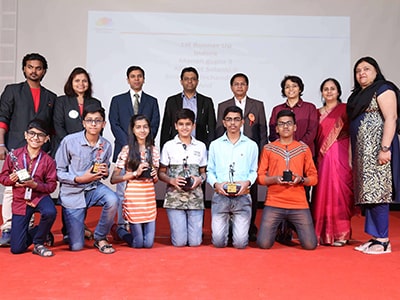Do you find yourself reading through a book every day, hoping that something sticks?
It is essential to adopt effective time management skills and learning techniques that will help you retain as much information as possible. The students of CBSE schools in Ahmedabad are encouraged to follow these types of study methods to help kids get through the academic year with a fresh strategy.
Tips on How to Study Effectively
To learn and retain information, you must first create the right conditions for learning and retention. These are some great study techniques and tips to try:
1. Getting a good night of sleep has a positive impact on student grades, says research. This doesn’t mean that you need to get 8 hours of sleep before taking a major test, rather getting enough sleep consistently should be a habit.
2. Planning an everyday timetable is the best study technique to ensure coverage of your syllabus within the time. However, be flexible to adjust small changes in the schedules at acceptable intervals.
3. Changing your study environment might not sound like a good tip for studying, but studies have shown that changing your environment can improve recall performance and enhance concentration.
4. Living healthy and minimizing distractions is an effective technique for learning. Consuming a healthy diet, keeping hydrated, and rewarding with healthy snacks are the ways to eliminate distractions.
7 Best Study Methods
Let’s get a detailed view of study methods for exam preparation –
1. The SQ3R Method
The SQ3R or SQRRR method is a reading comprehension strategy and SQ3R stands for the five steps in the reading comprehension process.
How to Use It?
● Survey: Instead of reading the whole book, skim the first chapter.
● Question: Ask questions about the chapter, such as “What is this chapter about? Is it inside my current knowledge about this topic?
● Read: Start by reading the entire chapter and look for the answers to your questions.
● Recite: Read a section and then summarize it in your own words.
● Review: After you’ve finished the chapter, it is important to go back and review it to make sure that you fully grasp the information.
Method Example
For the SQ3R method example, let’s choose Psychology and need-based theories of motivation.
1. Skim the chapter by reading the learning objectives.
2. Discover and review the key takeaways to focus on the important information.
3. After the survey generates questions based on the assimilated facts.
4. To find the answers to your questions read the entire chapter.
5. For better retention, recite whatever theories you have understood so far.
6. Review and highlight the important aspects in your prepared notes.
DOs and DON’Ts
| DOs | DON’Ts |
|
|
2. The PQ4R Method
The PQ4R Method method of the learning approach increases memorization and understanding capability. The acronym PQ4R stands for Preview, Question, Read, Reflect, Recite, and Review. PQ4R strategy is used to make reading easier.
How to Use It?
This PQ4R study method is a 6 step process.
1. Preview: Preview the information to get a sense of the subject. Read the headings, subheadings, and first and last paragraphs of a text.
2. Question: What are you expecting to learn about the topic? What is my current knowledge about the topic?
3. Read: Take a section for a while and read the information. Then, try to find answers to your questions.
4. Reflect: Did you answer all your questions? Go back and try again to find the answer.
5. Recite: Write down or speak a summary of what you have just read.
6. Review: Go back through the material and answer any questions you haven’t answered.
Method Example
While reading comprehension,
1. Read the topic and view the images and diagrams.
2. Ask yourself what ideas did you derive from the preview.
3. Read the entire passage and make notes.
4. Culture the facts in your mind whatever you inculcate from the comprehension.
5. Summarize or discuss the passage with other students.
6. Review the crucial points and ascertain whether your queries are answered.
DOs and DON’Ts
| DOs | DON’Ts |
|
|
3. The Feynman Technique
The Feynman Technique explains complex concepts in simple terms. It is based on the principle that “If you want something to be understood well, explain it simply.”
How to Use It?
1. At the top of each sheet of paper, write the subject or concept you are interested in.
2. Next, describe it in your own words.
3. Reread what you wrote and find any errors. Once you’ve identified the errors, review your writing and refer to your reading materials to find the correct answer.
4. Finally, if you find areas of your writing that contain technical terms or complex language in them, you can go back and rewrite them in simpler terms to make them more understandable.
Method Examples
Let’s incorporate Feynman’s learning technique in Pythagoras Theorem –
● Write the name of the theorem, with the formula beside it.
● Draw a small right-angled triangle marking the hypotenuse.
● Explain the theorem according to your comprehension.
● Solve a relatively complicated problem based on the theorem.
DOs and DON’Ts
| DOs | DON’Ts |
|
|
4. Pomodoro Technique
It is common for students to struggle with time management while doing assignments or preparing for exams. Francesco Cirillo created the Pomodoro Technique and this effective study method is based on his finding that the best way to learn is to break large tasks down into manageable timed units (“Pomodoro”).
How to Use It?
1. Determine what you want to do and how long you will be studying. Next, break down your work into Pomodoro.
2. Start studying by setting a timer for 25 mins.
3. Reduce distractions during the Pomodoro period. Pen down any thoughts that distract your mind.
4. Take a break for 5-10 minutes after 25 minutes, grab a cup of coffee, and go for a walk or call back a friend.
5. Repeat. After the completion of 4 Pomodoro take an extended break for 20-30 minutes.
Method Example
1. Plan the next-day schedule the previous night, review the pending syllabus and ongoing tasks.
2. Choose the subject, say, Mathematics, and fix a target; the number of chapters you aim to complete. Divide them among the Pomodoro.
3. Next day, view the Pomodoro plan, if it exceeds 10-12 Pomodoros, then shift a few for the next (this is to avoid over-burdening and not promoting procrastination)
4. Make a habit to include the Pomodoro planning in the daily routine.
DOs and DON’Ts
| DOs | DON’Ts |
|
|
5. Active Recall
The active recall method, also known as practice testing or active retrieval is an effective study technique of learning that allows you to learn by retrieving information from the brain.
Active recall learning is when you take a topic that interests you, create questions about it, and then test yourself repeatedly on these questions. It forces your brain to retrieve the information. The best schools in Gujarat have adopted active recall strategies for their students.
How to Use It?
Easily incorporate active recall techniques with these steps:
1. You can take whatever learning resource you have and create a list of concise questions based on the content.
2. Skip reading your notes and just go to the questions when you revise this topic.
3. If you make a mistake, go back to your notes to answer the question correctly next time.
Method Examples
1. Choose a subject, e.g., Economics.
2. Step out of your comfort zone and attempt to solve questions beyond your standard and forget about the outcome.
3. Highlight every question you answered wrong and revise and revisit those concepts frequently.
4. Practice all kinds of questionnaires – open-format, labeling, MCQs, flowcharts, or diagrams. Answering different question angles will make the concepts more concrete.
DOs and DON’Ts
| DOs | DON’Ts |
|
|
6. Retrieval Practice / Practice Testing
The concept of remembering later is the basis for retrieval practice strategies. Learning more is gained by recalling the answer to a question than by reading the answers in a textbook.
How to Use It?
You will remember more information if you practice retrieval. Here are some retrieval practice techniques to incorporate into your study schedule.
1. Practice tests: You can use practice questions to test your knowledge
2. Ask your questions. Be your teacher. Create questions that you would expect to see on a test.
3. Make flashcards but practice your retrieval techniques. Instead of flipping the card over, write down the answer and then verify.
Method Examples
Of course there are numerous examples, but let’s take into instance the quick-fire quiz activity.
1. Based on the syllabus the teacher asks out a set of questions, and the students write down the answers.
2. After all the questions, the teacher reveals the correct answers, and the students track them accordingly.
3. In the end, the teacher discusses the common mistakes and explains the correct ones.
DOs and DON’Ts
| DOs | DON’Ts |
|
|
7. Spaced Repetition Method
Spaced repetition is a technique that encompasses memorizing, reviewing, and recollecting facts at optimum intervals until it is retained at a sufficient level. Spaced repetition techniques can be incorporated to acquire knowledge and improve long-term memory.
How to Use It?
1. Plan the intervals in the study schedule based on the complexity and length of the topic, your intake capacity, and your knowledge regarding the topic.
2. The slot before the first interval should be a long one as it requires a first-time review and study of the material.
3. In the first spacing interval revise and recall the information already gathered. Repetition is necessary for a lasting impression of the concepts.
4. Keep repeating the repetitions at optimal intervals to enhance the learning process with new pieces of information.
Method examples
Let’s use the spaced repetition flashcard method with the Leitner System.
1. Take 5 small boxes for the experiment and the boxes represent different study time intervals.
2. Place flashcards with information in each box.
3. Once you recall the information in the first flashcard, move it to the second box with a less frequent time interval.
4. Repeat the process for all the flashcards.
5. Wherever you fail to recall information, move the flashcard to the previous box with a more frequent time interval.
DOs and DON’Ts
| DOs | DON’Ts |
|
|
Also Read: Reduced Syllabus of Class 10 Cbse 2022-23
Conclusion
Each student has their preferred study method. It could be that you read your textbook, use flashcards, highlight your notes, listen to or watch podcasts or make flashcards.
We often forget to ask ourselves: What revision method is the most effective? Do I maximize my work efficiency with it? It doesn’t matter which of the above-mentioned techniques you use for exam preparation, it is important to identify and adopt the best study technique suitable for you.





































